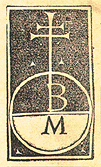
1491, (18 November) Venice: PIETRO DI PIASI CREMONESE
149[2], (3 March) Venice: BERNARDINO BENALI AND MATTEO DI CODECA
DA PARMA
Editors and correctors, whose ties with the printer-publishers were more
or less established, prepared texts for publication. Some editors and correctors
were in a printer's permanent employ while others were hired to work on
a single book. Both of these editions said in their colophons to have been
"emended by master Pietro da Figino, master of theology and excellent
Franciscan preacher" (thus reads Pietro di Piasi's edition). Pietro
da Figino's revised text of the Landino commentary continued to be reprinted
in the 16th century (including 1512, 1520 and 1529).
While the revisor has recently been identified as the Tuscan theologian
Pietro Mazzanti da Figline, documented to have been preaching in Venice
between1489-90, the chronological relationship between the two editions,
both dated 1491 in their colophons, remains problematic. Scholars have traditionally
followed the dating given in the books and thus granted precedence to the
Benali/Codecà imprint, but recent researches into the nature of Figino's
corrections of both the text and the Landino commentary reveal that the
di Piasi edition represents only a very modest revision of the text of 1484.
The Benali/Codecà imprint on the other hand presents a substantial
and attentive revision of the 1487 text. This has led to the supposition
that Pietro da Figino may have been dissatisfied with the cursory correction
he did for the di Piasi edition and therefore immediately undertook a new
edition for Benali/Codecà. This would explain the 3 March colophon's
expanded boast: "and he [Pietro da Figino] has added many things in
different places which he found lacking in all printed Dantes except this
one printed in Venice by Bernardino Benali and Matteo da Parma in 1491 on
the third day of March ...". Since the Venetian year began 1 March,
it is perhaps not too much to suppose that Benali/Codecà simply misdated
their edition which should have read 3 March 1492.
An important and distinctive characteristic of the di Piasi edition is that
for the first time a selection of Dante's canzoni was included after the
poem. Also of note are the letters of the alphabet in the margins which
were intended to serve as reference markers. The later 149[2] Codecà
imprint seeks to distinguish itself in a competitive market with the addition
of marginal glosses designed to assist the reader in finding points of interest.
1491 Edition
1492 Edition

